6.4 Cardiovascular Medications
Some of the more common cardiovascular system medications are discussed below. They are divided into several categories, with some having subcategories. Many of the medications can treat more than one of the pathologies that were discussed on the previous page, and they are often used in combination for better overall effects. Although medication treatment options are available for many of the pathologies already discussed in this chapter, often a stepped care approach is used for conditions such as hypertension and hyperlipidemia. This approach begins with lifestyle changes such as diet and exercise prior to the use of medications as a treatment option (Jakicic et al., 2012).
Diuretic Medications
Diuretics are used to decrease both blood pressure and the symptoms of fluid overload such as edema. There are many classifications of diuretics; please refer to Chapter 2, where loop, thiazide, and potassium-sparing diuretics are discussed in more detail.
Diuretics cause diuresis by inhibiting sodium and water reabsorption from the kidney tubules. Eliminating excess water decreases blood volume as well as blood pressure. Diuretics are often used in combination with other antihypertensive medications to reduce a patient’s blood pressure.
Antihypertensive Medications
Antihypertensive medications are used to treat high blood pressure. There are several categories of these medications, and each category is explained below.
Alpha-2 Agonist Medications
Alpha-2 agonist drugs stimulate the alpha-adrenergic receptors, resulting in vasodilation and decreased blood pressure, increased blood flow to the kidneys, and decreased afterload. An example of an alpha-2 agonist medication used for hypertension is clonidine (Catapres).
Other medications in this category include the following:
- guanfacine (Tenex)
- methyldopa (Aldomet)
(WebMD, 2023)
Beta-1 Antagonist (Beta-Blocker) Medications
Beta-1 antagonists medications, also known as beta-blockers, primarily block the beta-1 receptors in the heart, decreasing heart rate and blood pressure by dilating blood vessels (Heart and Stroke Foundation of Canada, 2023a). Medications in this category are commonly used to treat high blood pressure, chest pain caused by poor blood flow to the heart, and several heart conditions involving an abnormally fast heart rate.
Beta-1 antagonists are used as an early intervention during a myocardial infarction to reduce the workload on the heart. Before administering this type of medication, it is always important to check the patient’s pulse to ensure it is over 60 bpm.
The following is a list of common beta-1 antagonist medications:
- acebutolol (Sectral)
- atenolol (Tenormin)
- bisoprolol (Monocor)
- carvedilol (Coreg)
- metoprolol (Lopressor) (Figs. 6.10 and 6.11)
- propranolol (Inderal)
- timolol (Blocadren)
(Heart and Stroke Foundation of Canada, 2023)
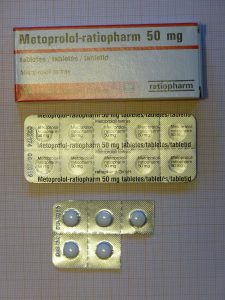
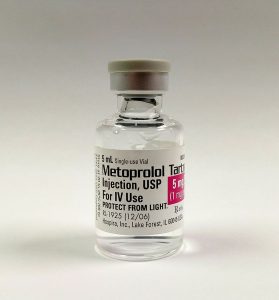
Key Concept
A common suffix with generic beta-1 antagonist medications is -olol.
Examples: acebutolol (Sectral), metoprolol (Lopressor)
Angiotensin Converting Enzyme (ACE) Inhibitors
Angiotensin converting enzyme (ACE) inhibitors block the conversion of angiotensin I to angiotensin II in the renin-angiotensin-aldosterone system (RAAS). This results in vasodilation and sodium and water excretion by blocking aldosterone, which in turn leads to lower blood pressure and decreased fluid volume. Medications in this category are used to treat hypertension and heart failure.
The following is a list of common ACE inhibitor medications:
- benazepril (Lotensin)
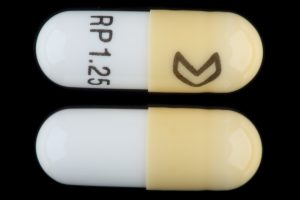
Fig. 6.12 - captopril (Capoten)
- cilazapril (Inhibace)
- enalapril (Vasotec)
- fosinopril (Monopril)
- lisinopril (Zestril)
- perindopril (Coversyl)
- quinapril (Accupril)
- ramipril (Altace) (Fig. 6.12)
- trandolapril (Mavik)
(Heart and Stroke Foundation, 2023b)
Key Concept
A common suffix seen with angiotensin converting enzyme (ACE) inhibitors is -pril.
Examples: captopril (Capoten), ramipril (Altace)
Angiotensin II Receptor Blockers (ARBs)
Angiotensin II receptor blockers are often referred to as ARBs. They are similar to ACE inhibitors in that they act on the renin-angiotensin-aldosterone system (RAAS). However, the difference is that they block angiotensin II and cause vasodilation and decreased peripheral resistance, which in turn lowers blood pressure. Medications in this category are used to treat hypertension and prevent heart attack, stroke, and heart failure (Cleveland Clinic, 2022).
Examples of angiotensin II receptor blocker medications:
- candesartan (Atacand)
- irbesartan (Avapro)
- losartan (Cozaar)
- telmisartan (Micardis)
- valsartan (Diovan)
(Cleveland Clinic, 2022)
Key Concept
A common suffix seen with generic angiotensin II receptor blockers (ARBs) is -sartan.
Examples: telmisartan (Micardis), losartan (Cozaar)
Calcium Channel Blockers
Calcium channel blockers increase the refractory period of the AV node by slowing the influx of calcium ions, which decreases the ventricular response and decreases the heart rate. This results in relaxation of the smooth muscle and vasodilation, which lowers blood pressure. These medications can also be used to control heart rate associated with supraventricular tachycardias.
The following is a list of commonly used calcium channel blockers:
- amlodipine (Norvasc)
- diltiazem (Cardiazem)
- felodipine (Plendil)
- nifedipine XL (Adalat XL)
- verapamil (Isoptin)
(Heart and Stroke Foundation of Canada, 2023c)
Key Concept
A common suffix with generic calcium channel blockers is -dipine.
Example: felodipine (Plendil), amlodipine (Norvasc)
Combination Drugs for Hypertension
Diuretics are often used in combination with other antihypertensive agents to reduce a patient’s blood pressure. Most of the medications listed above can be combined with a diuretic. Hydrochlorothiazide (Fig. 6.13) is a common thiazide diuretic used in combination with some of the above antihypertensives. It is often abbreviated as HCT in the name of the medication.
The following is a list of common combination medications used in the treatment of hypertension:
- Accuretic (contains quinapril and hydrochlorothiazide)
- Diovan HCT (contains valsartan and hydrochlorothiazide)
- Inderide LA (contains hydrochlorothiazide and propranolol)
- Dutoprol (contains metoprolol and hydrochlorothiazide)
(MedlinePlus, 2021)
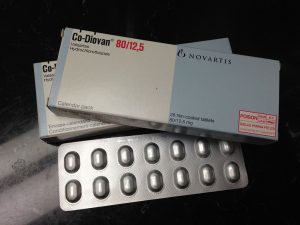
The video below discusses the different categories of antihypertensives.
(Dr Matt & Dr Mike, 2019)
Antiarrhythmics
Antiarrhythmic medications regulate heart rate and rhythm by manipulating the conduction of electrical signals to change the heart rate or to attempt to revert an arrhythmia to a normal sinus rhythm. All antiarrhythmic medications have a risk of producing an arrhythmia. Some antiarrhythmic medications are used during emergency situations such as cardiac arrest, whereas others are used long term, such as those used to control atrial fibrillation. Monitoring electrolytes and ECG patterns are very important assessments that may need to be performed on patients taking these medications. This medication category is divided into classes, which are listed and described below.
Class I – Sodium Channel Blockers
Class I medications are sodium channel blockers and slow conduction and prolong depolarization by decreasing sodium influx into cardiac cells. Quinidine is an example of this class of medication. This medication is typically used for life-threatening ventricular dysrhythmias such as ventricular tachycardia or for the conversion of atrial fibrillation that has not responded to other therapy.
The following is a list of sodium channel blocker medications:
- lidocaine (Xylocaine)
- flecainide acetate (Tambocor)
- quinidine
(WebMD, 2023)
Class II – Beta-Blockers
Class II medications are beta-blockers and are used to decrease conduction velocity, automaticity, and the refractory period of the cardiac conduction cycle. Betapace (Sotalol) is a beta-1 and beta-2 blocker that also has Class III antiarrhythmic properties. Recall that other types of beta-blockers, such as metoprolol (Lopressor), are also used to treat hypertension. Sotalol is given to patients for life-threatening arrhythmias, including ventricular arrhythmias or supraventricular arrhythmias.
Class III – Potassium Channel Blockers
Class III medications, potassium channel blockers, prolong repolarization by blocking the potassium channels in the cardiac cells that are responsible for repolarization. They are used for emergency treatment of ventricular dysrhythmias that have not responded to other available antiarrhythmics or when alternative agents could not be tolerated. Amiodarone (Cordarone) is an example of a medication with Class III properties.
Class IV – Calcium Channel Blockers
Class IV medications, calcium channel blockers, include verapamil (Isoptin) and diltiazem (Cardiazem) (Heart and Stroke Foundation of Canada, 2023c). These medications increase the refractory period of the AV node by slowing the influx of calcium ions, thus decreasing the ventricular response and decreasing the heart rate. These medications may be used to control heart rate associated with supraventricular tachycardias. Calcium channel blockers are also used to treat hypertension because they relax smooth muscle and cause vasodilation, as noted earlier in this section.
Adenosine
Adenosine is a unique medication given to patients who are experiencing paroxysmal supraventricular tachycardia. It is given in a single dose as a bolus to slow electrical conduction and restore a normal sinus rhythm. It is an emergent type of medication.
Cardiac Glycosides
Digoxin (Lanoxin) is a cardiac glycoside medication that has been used for centuries to treat heart failure. It can be taken orally and intravenously (Figs. 1.14 and 6.15) (WebMD, 2023). It has three effects on heart muscle: positive inotropic action (increases contractility and stroke volume to increase cardiac output), negative chronotropic action (decreases heart rate), and negative dromotropic action (decreases the conduction of cardiac cells) (McCuistion et al., 2018). Digoxin is used to treat heart failure and atrial fibrillation, but it is being used less often because of the risk of toxicity, bradycardia, nausea, vomiting, visual changes, and arrhythmias.
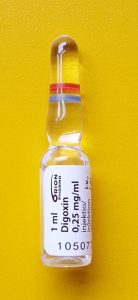
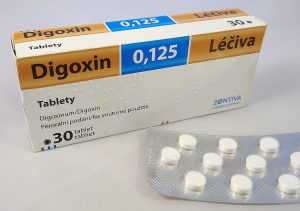
Antianginal Medications – Nitrates
Antianginal medications are used to treat angina pectoris. Angina is chest pain caused by inadequate blood flow, resulting in hypoxia of the cardiac tissue. It can be chronic pain caused by atherosclerosis in coronary artery disease or acute pain caused by a myocardial infarction.
Antianginals increase blood flow to the heart or decrease oxygen demand by the heart. Nitrates promote vasodilation of the coronary arteries and veins. Beta-blockers and calcium channel blockers are also used to decrease the workload of the heart and decrease oxygen demands.
Nitrates can be administered in a variety of routes, such as sublingual, extended-release tablets, creams, transdermal patches, and intravenously (Fig. 6.16). Sublingual tablets are prescribed PRN for patients who are experiencing chronic, stable angina caused by coronary artery disease.
An example of a nitrate medication is nitroglycerin (Nitro-Bid).
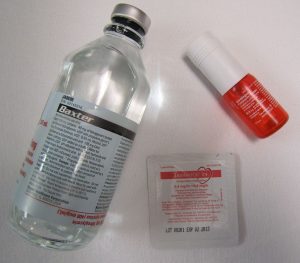
Antilipidemic Medications
HMG-CoA Reductase Inhibitors
Antilipidemic agents reduce hyperlipidemia that may lead to additional health problems such as stroke, myocardial infarction, angina, and heart failure. Medications in this category inhibit HMG-CoA reductase and cholesterol synthesis, which reduces LDL (low-density lipoprotein) cholesterol. These medications should be used together with a healthy diet and exercise regime.
The following is a list of common HMG-CoA reductase inhibitors:
- atorvastatin (Lipitor)
- fluvastatin (Lescol)
- pravastatin (Lipostat)
- rosuvastatin (Crestor)
- simvastatin (Zocor)
(WebMD, 2023)
Key Concept
A common suffix with generic HMG-CoA reductase inhibitors is -statin.
Example: atorvastatin (Lipitor), rosuvastatin (Crestor)
Medications in this category are often referred to as statins (Mayo Clinic, 2022).
Selective Cholesterol Absorption Inhibitors
Medications in this category are used to treat hyperlipidemia and familial hypercholesterolemia. Ezetimibe (Zetia) is an example of a medication in this category. It works by blocking the absorption of cholesterol in the small intestines to reduce LDL (WebMD, 2023).
Blood Coagulation Modifiers
Blood coagulation modifiers affect blood coagulation and include several types of medications such as anticoagulants, antiplatelets, and thrombolytics, as well as their associated reversal agents. Medications in this category are used to treat such pathologies as deep venous thromboembolism (DVT), pulmonary embolism, and acute myocardial infarction. The next chapter on the hematological system and medications will discuss this medication category in detail.
Table 6.1. Common Cardiovascular System Medications
| Generic Name | Trade Name | Reason for Administering |
| clonidine | Catapres | hypertension |
| guanfacine | Tenex | hypertension |
| methyldopa | Aldomet | hypertension |
| acebutolol | Sectral | hypertension, myocardial infarction |
| atenolol | Tenormin | hypertension, myocardial infarction |
| bisoprolol | Monocor | hypertension, myocardial infarction |
| carvedilol | Coreg | hypertension, myocardial infarction |
| metoprolol | Lopressor | hypertension, myocardial infarction |
| propranolol | Inderal | hypertension, myocardial infarction |
| timolol | Blocadren | hypertension, myocardial infarction |
| benazepril | Lotensin | hypertension, heart failure |
| captopril | Capoten | hypertension, heart failure |
| cilazapril | Inhibace | hypertension, heart failure |
| enalapril | Vasotec | hypertension, heart failure |
| fosinopril | Monopril | hypertension, heart failure |
| lisinopril | Zestril | hypertension, heart failure |
| perindopril | Coversyl | hypertension, heart failure |
| quinapril | Accupril | hypertension, heart failure |
| ramipril | Altace | hypertension, heart failure |
| trandolapril | Mavik | hypertension, heart failure |
| losartan | Cozaar | hypertension, prevention of heart attack, stroke, and heart failure |
| valsartan | Diovan | hypertension, prevention of heart attack, stroke, and heart failure |
| candesartan | Atacand | hypertension, prevention of heart attack, stroke, and heart failure |
| irbesartan | Avapro | hypertension, prevention of heart attack, stroke, and heart failure |
| telmisartan | Micardis | hypertension, prevention of heart attack, stroke, and heart failure |
| amlodipine | Norvasc | hypertension |
| felodipine | Plendil | hypertension |
| nifedipine XL | Adalat XL | hypertension |
| quinapril, hydrochlorothiazide | Accuretic | hypertension |
| valsartan, hydrochlorothiazide | Diovan HCT | hypertension |
| hydrochlorothiazide, propranolol | Inderide LA | hypertension |
| metoprolol, hydrochlorothiazide | Dutoprol | hypertension |
| lidocaine | Xylocaine | arrhythmias |
| flecainide acetate | Tambocor | arrhythmias |
| quinidine | no brand name | arrhythmias |
| betapace | Sotalol | arrhythmias |
| amiodarone | Cordarone | arrhythmias |
| adenosine | – | arrhythmias |
| diltiazem | Cardiazem | hypertension, arrhythmia |
| verapamil | Isoptin | hypertension, arrhythmia |
| digoxin | Lanoxin | heart failure, atrial fibrillation |
| nitroglycerine | Nitro-Bid | angina |
| atorvastatin | Lipitor | high cholesterol |
| fluvastatin | Lescol | high cholesterol |
| pravastatin | Lipostat | high cholesterol |
| rosuvastatin | Crestor | high cholesterol |
| simvastatin | Zocor | high cholesterol |
| ezetimibe | Zetia | high cholesterol |
Attribution
Unless otherwise indicated, material on this page has been adapted from the following resource:
Ernstmeyer, K., & Christman, E. (Eds.). (2020). Nursing pharmacology. Chippewa Valley Technical College. https://wtcs.pressbooks.pub/pharmacology/, licensed under CC BY 4.0
References
Cleveland Clinic. (2022). Angiotensin II receptor blockers (ARBs). https://my.clevelandclinic.org/health/drugs/23327-angiotensin-ii-receptor-blockers
Dr Matt & Dr Mike. (2019). Blood pressure drugs | Pharmacology [Video]. YouTube. https://www.youtube.com/watch?v=Ab57aXNNw34
Heart and Stroke Foundation of Canada. (2023a). Beta-blockers. https://www.heartandstroke.ca/heart-disease/treatments/medications/beta-blockers
Heart and Stroke Foundation of Canada. (2023b). ACE (angiotensin converting enzyme) inhibitors. https://www.heartandstroke.ca/heart-disease/treatments/medications/angiotensin-converting-enzyme-inhibitors
Heart and Stroke Foundation of Canada. (2023c). Calcium channel blockers. https://www.heartandstroke.ca/heart-disease/treatments/medications/calcium-channel-blockers
Jakicic, J. M., Tate, D. F., Lang, W., Davis, K. K., Polzien, K., Rickman, A. D., Erickson, K., Neiberg, R. H., & Finkelstein, E. A. (2012). Effect of a stepped-care intervention approach on weight loss in adults: A randomized clinical trial. JAMA, 307(24), 2617–2626. https://doi.org/10.1001/jama.2012.6866
Mayo Clinic. (2023). Statin side effects: Weigh the benefits and risks. https://www.mayoclinic.org/diseases-conditions/high-blood-cholesterol/in-depth/statin-side-effects/art-20046013#:~:text=Statins%20include%20atorvastatin%20(Lipitor)%2C,of%20heart%20attacks%20and%20strokes
McCuistion, L. E., Vuljoin-DiMaggio, K., Winton, M., & Yeager, J. J. (2018). Pharmacology: A patient-centered nursing process approach (9th ed., pp. 443–454). Elsevier.
MedlinePlus. (2021). Hydrochlorothiazide. https://medlineplus.gov/druginfo/meds/a682571.html
WebMD. (2023). Drug & medications A–Z. https://www.webmd.com/drugs/2/index
Image Credits (images are listed in order of appearance)
Metoprolol-ratiopharm by Dmitry G, Public domain
Metoprolol 1 (cropped) by Mark Oniffrey, CC BY-SA 4.0
Ramipril 1.25 MG Oral Capsule by National Library of Medicine (NLM), Public domain
Two boxes and a blister pack of Co-Diovan (Valsartan and hydrochlorothiazide), Singapore – 20150210 by Smuconlaw, CC BY-SA 4.0
Digoxin 1ml vial yellow background by Wesalius, CC BY 4.0
Digoxin 0,125 mg tbl by Tomino de WS, CC BY-SA 4.0
Nitro by James Heilman, MD, CC BY-SA 3.0
swelling in the body, often in the lower limbs
increase in urine output
widening of the blood vessels
the pressure that the heart needs to contract to eject blood
heart attack
irregular heart rhythm
medication that promotes polyuria (increased urine output)
irregular heart rhythm
irregular and fast heartbeat that can lead to other pathologies
irregular heartbeat in the ventricles
a type of arrhythmia that presents with a regular but rapid heartbeat that starts and stops abruptly
chest pain caused by inadequate supply of blood and oxygen to an area of the heart
decreased supply of oxygen to the tissues
hardened with plaque
disease caused by plaque buildup in the arteries
under the tongue
abbreviation for "as needed"
high lipid levels in the blood
a blood clot in the lungs

